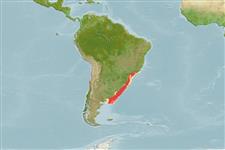Common names from other countries
Classification / Names / Names
Nomi Comuni | Sinonimi | Catalog of Fishes (gen., sp.) | ITIS | CoL | WoRMS
Environment: milieu / climate zone / depth range / distribution range
Ecologia
; acqua dolce; distribuzione batimetrica 4 - 200 m (Ref. 83435). Tropical, preferred 18°C (Ref. 107945); 23°S - 42°S, 74°W - 42°W
Southwest Atlantic and Southeast Pacific: From Rio de Janeiro, Brazil to San Matiás Gulf, Argentina. In the Pacific it is found in Chile. Tropical to subtropical.
Length at first maturity / Size / Peso / Age
Maturity: Lm ?, range 12 - 13 cm Max length : 27.0 cm DL maschio/sesso non determinato; (Ref. 83435)
Minimum depth range from Ref. 122063. Lives in shallow waters at maximum depths of 4 m during low tide. Found on sandy subtrates with boulders and sponges. Individuals spend most of their time buried. Females attach their egg capsules to benthic hard substrata such as mollusk shells and/or pebbles (Ref. 122063). Voracious predator on bivalves (Ref. 114777).
Life cycle and mating behavior
Maturità | Riproduzione | Deposizione | Uova | Fecundity | Larve
This species is a non-broadcast spawner. Life cycle does not include trocophore stage. Also Ref. 833.
SAUP Database. 2006. (Ref. 356)
IUCN Red List Status (Ref. 130435)
CITES status (Ref. 108899)
Not Evaluated
Not Evaluated
Human uses
Pesca: commerciale
FAO - pesca: landings | FishSource | Sea Around Us
Strumenti
Fonti Internet
Estimates based on models
Preferred temperature
(Ref.
115969): 19.5 - 21.2, mean 20 (based on 9 cells).
Resilienza
Medio, tempo minimo di raddoppiamento della popolazione 1.4 - 4.4 anni (K=0.21; tm=8.5).
